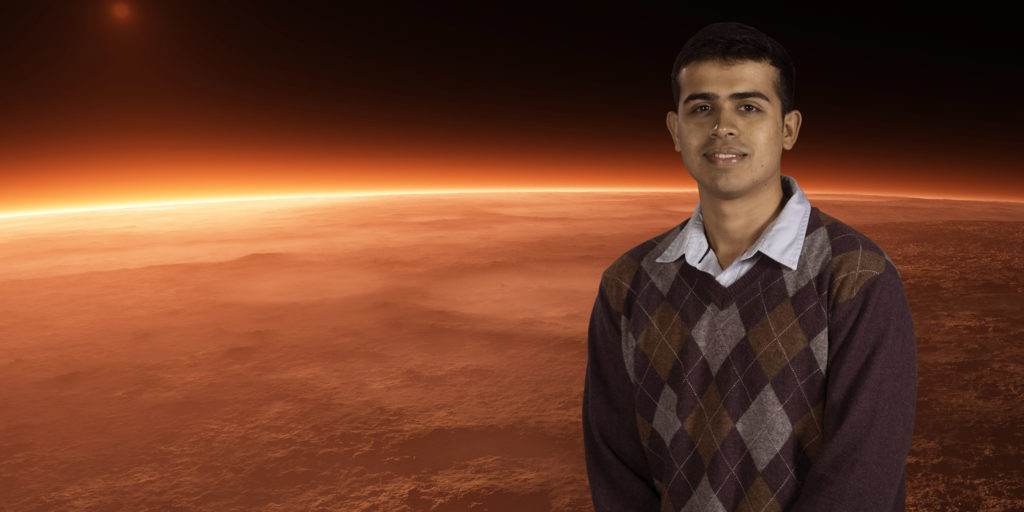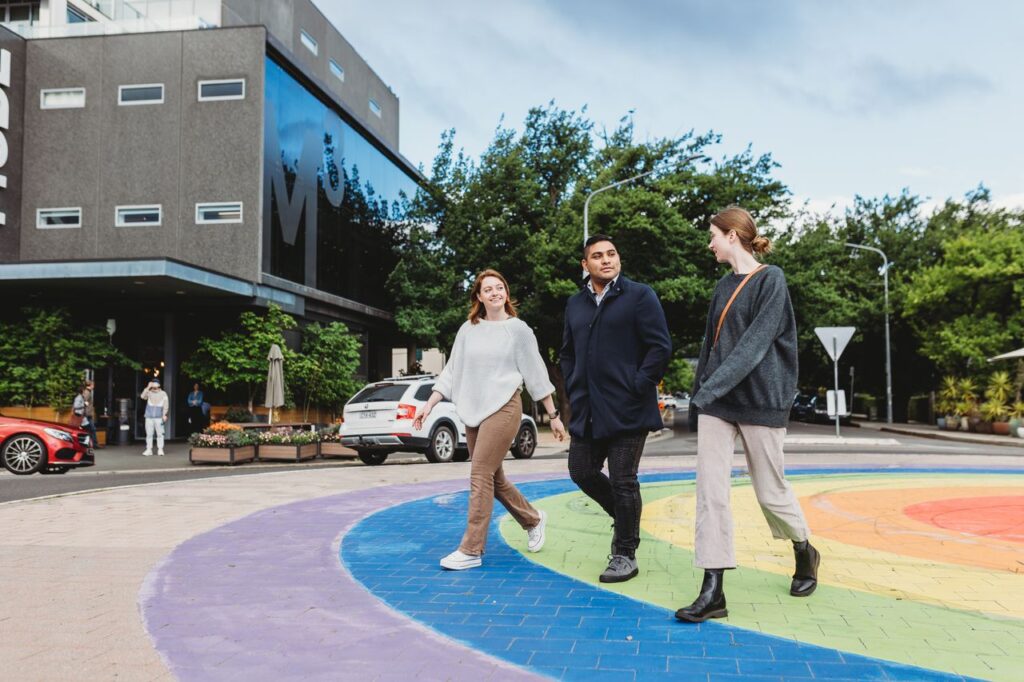In 2018, the Australian Government announced it would set up the Australian Space Agency, Australia’s first major agency of its kind.
The agency is currently headquartered in Canberra, which is the new hotspot for space exploration in Australia. It’s the city where two of Australia’s leading space programs sit, with the Australian National Concurrent Design Facility at the University of New South Wales, Canberra (UNSW Canberra), and Australian National University (ANU) National Space Test Facilities.
UNSW Canberra has among the largest space research and education capabilities in Australia, and together with ANU, the two are the most active in space-related disciplines in Australia. The University of Canberra, too, is working with NASA to help get people to Mars.
Siddharth Pandey could not be more excited. A past student of UNSW Canberra, Siddharth is currently completing his Australian PhD in Aerospace Engineering, having previously finished an undergraduate degree in India and a Masters in the Netherlands. He has also worked at NASA’s Ames Research Center in the United States. In 2015, Siddharth was a Student Ambassador for Study Canberra and is currently involved with the Mars Society Australia and the Blue Marble Space Insitute of Science.
We sat down with Siddharth to get his story.
Looking to the stars
It was news of a major space shuttle accident that first sparked young 12-year-old Siddharth’s fascination with space exploration and aerospace engineering. It’s a fascination he’s held for almost 15 years since.
“One of the astronauts on board [Kalpana Chawla] was an Indian-origin astronaut,” he says. “That really got my attention at that age. From there, I have had dreams of becoming an astronaut. Since then, it’s been this single motivation to follow the career path most astronauts do.”
This career path, Siddharth explains, usually involves getting an undergraduate degree, a Masters degree, working for a while, and eventually pursuing a PhD.
“You’re trying to be the best at what you do within the aerospace domain, and then you kind of work yourself towards an agency or an institute that recruits people to go into space,” he says. “Since then, my fascination with space helped one thing lead to another.”
Launching into a new life in Canberra
Why it’s worth pursuing a PhD
Whilst Siddharth dreamed of becoming an astronaut, he realised that to get there, learn, grow and reach that ultimate goal, he would also have to find a day job he loved – a career in aerospace.
“A dream of becoming an astronaut is something that takes a long time to achieve,” he says. “You have to really love what you do while you’re trying to become one.”
After getting his Masters and working at NASA Ames in the US, Siddharth very quickly understood the benefits of undertaking further study.
“[Having a PhD] gives you a niche,” he says. “So wherever I am – whether I’m in Australia, in India, or in the US – having a PhD really helps you get some opportunities which you otherwise would not have.”
Studying in Canberra
When Siddharth’s supervisor offered him a scholarship to undertake a PhD in Aerospace Engineering in Canberra, Siddharth jumped at the opportunity to go. He was particularly excited that Canberra was two hours away from both the beach and the snow.
“I really enjoyed going for hikes and treks around Canberra – Mount Ainslie, or Black Mountain, or Tidbinbilla. Once I got a car, I would drive to the coast and to the Snowy Mountains. Bushwalking was one of my favourite activities while I was there,” he says. “We were just ten minutes’ walk from a lake, and it was a small city with not much traffic. [It was] easy for students to move around. Also, the government in Canberra supports international students by giving them student concessions!”
In particular, Siddharth loved the study-intensive nature of doing a three-year PhD program in Australia.
“PhD programs in Australia are time-bombs; [they take around] three-and-a-half years. For people who cannot afford to go back to school for more than four years or so – such as in India and the US – if you start grad school, it’s almost a six-year affair!” he says. “So, for the few of us who are already into their careers and really want to have a quick, concentrated PhD, the Australian PhD program is quite ideal.”
A sense of community
In 2015, Siddharth was a Study Canberra Student Ambassador. This saw him supporting other students in the community and getting involved in city events.
“Study Canberra helped me connect with people within the ACT Government,” Siddharth says. “And I’m personally involved in education outreach work both in India and in Australia. I am a Director of the Mars Society Australia, which is a nonprofit research society that does Space exploration outreach work for students, as well as the general public.”
Siddharth enjoyed being involved with the community, putting together displays and talking to students as part of several National Science Week events. “All in all, I think Canberra has a really nice ‘small-town’ feel that’s really difficult to get if you’re in a bigger city.”
Exploring Space in Canberra
“The University of New South Wales, Canberra … has such an extensive space research program,” Siddharth says. “It gave me insight into doing both simulations and experiments.”
During the program, Siddharth became part of a group that worked on a simulation chamber at UNSW Canberra. “It’s a large chamber that we have in which we can simulate planetary environments such as Mars environments. [We can also] simulate Mars temperatures and pressures. I’d been involved in Mars research, but I’d never really been involved at an academic level or a university research level on such a project. I really enjoyed working on that.”
Siddharth also participated in community networking events and society meet-ups. He often assisted with events run by the Mars Society Australia and the Sydney section of AIAA, the American Institute of Aeronautics and Astronautics – an international aerospace network.
The Future: To Infinity and Beyond!
Siddharth is looking forward to seeing what developments, jobs and new research opportunities will come forth after the recently announced Australian Space Agency. If everything were dependent on living factors, Siddharth says he would love to stay in Australia.
“I really enjoyed my time in Australia. I can even say that, of all the countries I’ve lived in, the kind of standard of living and comfort that I’ve found in Australia, I didn’t find either in the US or in the Netherlands. It was just such a comfortable place to be. If I wasn’t in India, I think I would be in Australia.”
But for now, he must go wherever his job takes him. “Now, as far as jobs are concerned, if I have a dream, I have to work towards it and find the closest best projects that I can add to my profile so that, once I apply to become an astronaut, I have had the right experience,” he says. “So that will kind of determine where I go.”
Words of advice for future space explorers
“If you have a good set of friends, there are tonnes of activities for you to do in Canberra – whether it be recreation activities, e-sports, or anything else!” Siddharth says. “Make the most of the fact that you’re still in a city which has no traffic and no pollution, and you can drive and walk around without any such concerns.”
When Siddharth reflects upon his journey, he feels pride. He says he is lucky to have a family who has been supportive, but advises everyone to follow to their dreams.
“Just keep it up. Don’t change for anyone else, keep doing what you have,” he says. “At the same time, you need to have the right mix of being flexible, but … being firm about your dreams.
“At the end of the day, just do the best you can at whatever you do. In terms of ‘career’, it really doesn’t matter – just do what you like, and if a place is giving you an opportunity, you should check it out.”





